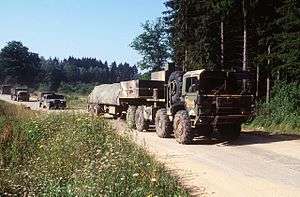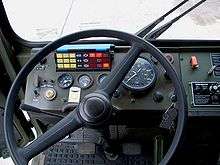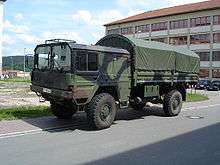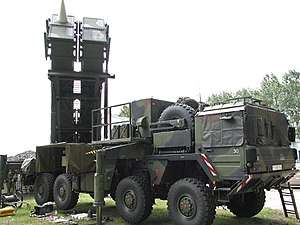MAN KAT1
The MAN KAT1 is a family of high-mobility off-road trucks developed by MAN SE for the German army.
| KAT1 | |
|---|---|
 MAN KAT1 | |
| Type | 8x8, 6x6, and 4x4 off-road trucks |
| Place of origin | Germany |
| Service history | |
| Used by | West Germany, Belgium, Austria, USA, Estonia and probably others |
| Production history | |
| Manufacturer | MAN SE; RMMV would now be the design parent |
| Produced | 1976-1981 |
| No. built | 9110 (approx) |
| Specifications | |
| Engine | MAN diesel (KHD diesel in early models) |
| Suspension | coil springs |
History
In 1962 the Bundeswehr planned to replace its fleet of vehicles which at the time still stemmed from the time the Army had been founded. The Bundeswehr desired amphibious two-, three- and four-axle vehicles in the 4 to 10 ton payload range. Because a high degree of new development was necessary, the German Federal Agency for Defence Technology and Procurement (Bundesamt für Wehrtechnik und Beschaffung, BWB) found itself unable to accept the responsibility for a decision, so suggested the bidding companies form a common development bureau and agree on one unified project. Two years later in 1964, the "Common Bureau of the German Utility Vehicle Industry" (Gemeinschaftsbüro der deutschen Nutzfahrzeugindustrie) was formed under the leadership of MAN. The manufacturers Klöckner-Humboldt-Deutz (KHD), Büssing, Krupp and Henschel were also on board.
On 12 August 1964, BWB drafted its second generation requirements. Specification of the next generation called for mostly standard commercial vehicles with unlimited cross-country mobility, amphibious, with permanent all-wheel drive, low-pressure run flat tires, a steel cab, NBC protection, a multifuel engine, and a minimum service life of ten years.
Because procurement costs would have run too high and NATO established a new standard, the amphibious, NBC and multifuel capabilities were subsequently cancelled and requirements were re-drafted again. Payload of the twin-axle version was increased to 5 t, fording depth specified to 1,200 mm, loadbed height raised to 1,650 mm, and air cooled Deutz V8 engines with and without turbocharger as well as 14.00 R 20 size tyres were specified. However, even this 'trimmed-down' version was too expensive for comprehensive procurement. After further deliberations it was decided to procure a smaller number of the specialised, newly developed high-mobility trucks and supplement them with a number of near-standard trucks. This meant the army procured six different new truck models, initially three of them in the high-mobility off-road category.
On 4 December 1975, the Bundeswehr and MAN signed the procurement contract covering the delivery of the special military trucks, now split even further into two more categories. The first Kategorie I-MAN, the 10 t mil gl, was delivered on 29 November 1976.
The original intention was to build a family of logistics vehicles which could carry full loads across severe terrain whilst keeping up with modern main battle tanks.[1]
The first model produced was 8x8; 6x6 and 4x4 variants followed.[2]
The original KAT 1 design evolved into the MAN SX.[3] A few ex-military MAN KAT1 vehicles are released onto the second-hand market in Germany.[4]
US military
The United States Army and the United States Air Force operated four variations of the KAT 1 8x8 under the designations M1001, M1002, M1013 and M1014.[5]
- Truck Tractor w/Crane, 10-ton, 8X8 M1001 (NSN 2320-12-191-5422)
- Truck Tractor w/Crane, 10-ton, 8X8, M1002 (NSN 2320-12-191-5423)
- Truck Tractor w/Crane, 10-ton, 8X8, M1013 (NSN 2320-12-191-5424)
- Truck Tractor w/o Crane, 10-ton, 8X8, M1014 (NSN 2320-12-191-5425)
The M1001 was used by the US Army as the prime mover for the Pershing II nuclear missile. The tractor was configured with a fifth wheel to tow the erector launcher, an Atlas Maschinen GmbH 8-ton crane for handling missile components and a 30 kW generator to power the erector launcher. The M1002 was configured as a recovery vehicle with a Rotzler recovery unit, earth spades, Atlas Maschinen GmbH AK4300 M5 crane, and carriers for two erector launcher spare tires.
The M1013 was used by the US Air Force as the prime mover for the Gryphon Ground Launched Cruise Missile (GLCM). The tractor was configured with a fifth wheel to tow the launcher, a 2-ton material handling crane and a self-recovery winch. The M1014 was also configured as a prime mover and had a tire carrier for a launcher spare tire.
General characteristics

Identical to 5 t and 7 t

Introduced as the mil gl (for "militarisiert geländegängig" - military, cross country mobile), the MAN KAT 1 series is used by all branches of the Bundeswehr. Militarization includes a full blackout lights circuit completely separated from the standard lights, a military instrument layout with blackout option, an emergency stop switch to cut electrical power, a roof hatch with machine gun mount, and rifle brackets. The vehicles are Category I (KAT I) special military developments, and as such fully cross-country mobile.
The KAT I vehicles of the 5 t, 7 t, 10 t payload classes belong to the second generation of Bundeswehr vehicles (Folgegeneration), and the KAT I A1 designated vehicles belong to the "expanded second generation" which also includes a 15-ton version. KAT I vehicles underwent a complete overhaul in the mid-1990s to extend their service life by another ten years, and replacemnet has only recently begun in earnest.
Category I A1.1 vehicles (KAT I A1.1) like the 15 t mil gl "Multi", supporting the "Wechselladersystem Multi" multi mission container system, belong to the third generation and have been developed further but are still military special developments.
The vehicles are widely known as the "5-, 7-, 10-, 15-Tonner", which denotes their military payload class (maximum load in metric tons). "Tonner" has developed into Bundeswehr jargon for "truck".
Design
All trucks of the KAT 1 and follow-on series share a modular design. They have a torsionally rigid box-section frame with rigid hub-reduction axles linked to the frame via coil springs. The engine is mounted inside the forward-control cab, which is separated into a driver and engine compartment by a firewall. As a distinctive feature, the engine is located to the rear of the driver compartment instead of beneath it. This way, the total height could be kept below 2.9 m, which means the trucks can be transported on standard railway flatcars. The characteristic, cut-away corners of the otherwise box-shaped cab ensure compliance with the railway loading gauge. The cab of early production examples does not tilt forward for maintenance because the vehicles were still based on the amphibious prototypes. The tilting cab was only introduced in the mid-80s.
The engine powers the front and rear axles via a torque converter, semi-automatic transmission and a transfer case. In the first batch KAT I, these components form a single, special unit. The later KAT I A1 series uses mass-produced and standard truck components. At the same time, this allowed to raise the number of gears from six to 16, and the theoretical top speed from 90 to about 130 km/h. This in turn led to much lower engine speeds at the usual top speed of 80 km/h, lowering fuel consumption. Vehicle voltage is standard 24 Volts. The tow hitch is a standard NATO coupling suitable for towing trailers even in difficult terrain, although they must be equipped with the matching lunette ring.
For self-defense, the vehicles have a swiveling machine gun mount for the Rheinmetall MG3.
For the extraterritorial deployment of the Bundeswehr, some vehicles were fitted with an additional modular armour (modulare Schutzausstattung, MSA) to increase crew protection. Some new 3rd generation vehicles have the so-called vehicle protective equipment (Fahrzeugschutzausstattung, FSA) which is part of the vehicle design and factory-installed.
Variants (second generation)
LKW 5 t mil gl KAT I und KAT I A1 (4×4)

Introduced between 1976 and 1985, the types 451 and 461 are powered by a Deutz V8 Diesel engine, type F8L413F with 256 hp. These trucks are mainly flatbeds and covered wagons used to transport material and troops, carriers for the Kabine II of the fire control system (FERA) of the Light Artillery Rocket System (LARS) and as recovery vehicle for the KZO "Brevel" drone, equipped with a 1-ton crane by Atlas-Weyhausen.
A specialty are the tank trucks based on the 5 t mil gl. With the tank attachment ("Tankaufsatz", TA) with pump, either with 1x 4600 l or 2x 2300 l tanks, they exceed the max. gross weight by one ton. After tests and with the consent of the tire manufacturer, it was decided to increase the tire pressure to compensate. All of these vehicles have a certificate of exemption.
In contrast to type 451, the type 461 vehicles are equipped with a 5-ton winch with 30m of steel cable, denoted by the letter "w" in their designation (5 t mil glw). The cable can be played out to the front and to the rear. Almost all of the 2,073 winch-equipped trucks went to the army branch.
Between 1986 and 1993, the German Air Force (Luftwaffe) ordered further vehicles which could be airlifted in Lockheed C-130 Hercules and Transall C-160 transport aircraft. This new generation, termed KAT I A1, had some minor improvements over the first generation and some slight modifications. For example, the fixed cab was modified to expedite changing the engine. For airlift, the cab received a bolt-on hardtop.
LKW 7 t mil gl KAT I and KAT I A1 (6x6)


The 7-ton payload trucks were the second vehicle of the second generation of MAN Kat1 series trucks. These are very similar to the 5-ton truck but with a second, powered rear axle and a more powerful air-cooled 320 hp Deutz engine with turbocharger and intercooler. The second rear axle is powered by a fixed drive through the first one.
MAN produced five types of these between 1977 and 1985. The types 452, 462 (with winch) and 463 served as flatbed trucks, carriers for the reconnaissance drone CL289, carriers for the LARS multiple rocket launcher, and with engineer units as a tractor for the mine-laying trailer 85 (MiV85) and the three-axle flatbed trailer 15 t. The type 453 was built as a dump truck with winch for the engineer units and a container truck for the medical corps. The fifth type of the follow-up generation was a carrier for the folding pontoon bridges. This type 455 has a lengthened wheelbase and flatbed to carry all components of the bridge and the M-Boot 3 motorboat. Like the type 462, it also has a 5-ton winch.
In total, MAN produced 3,500 KAT I trucks of the 7-ton class.
In the early 1980s, the Luftwaffe ordered additional vehicles as it had done with the 5-ton version. Between 1986 and 1993, MAN supplied vehicles of the improved KAT I A1 version for the MIM-104 Patriot surface-to-air missile system. The truck served as carrier for the fire control and engagement control systems as well as the electric power plant 2×150 kW and the antenna mast group.
LKW 10 t mil gl KAT I (8x8)
The final member of the KAT-I family is the four-axle, 10-ton version. Equipped with a 320 hp Deutz engine, turbocharger and intercooler, this truck is used by the supply units on the division, brigade and corps level of the German army. It has an extended bed and is used to supply the combat units with mass consumables like ammunition and fuel. Between 1976 and 1985, MAN built two versions. Type 454 only had a 5-ton winch by Rotzler and depended on fork lift trucks and the like. The type 464 had a 1-ton loading crane by Atlas-Weyhausen, mounted in the middle of the bed to the left. Because of the crane, this type can only carry nine EUR-pallets.
 MAN 10 t gl with loading crane
MAN 10 t gl with loading crane
Load: propellant charges for artillery shells; crane is beneath the brown tarp Deployed Atlas-Weyhausen 1-ton loading crane
Deployed Atlas-Weyhausen 1-ton loading crane
The expanded follow-up generation KAT I A1, the follow-up generation 3 and the multi mission module MULTI were developments based on the 10 t mil gl and glw.
LKW 15 t mil gl KAT I A1 (8x8)


In the early 1980s, MAN supplied the Luftwaffe with improved vehicles of the KAT I A1 version as carriers in the 15-ton class. The 15 t mil gl BR A1 trucks, modified with a wider track of 2,900 mm, served as carriers and launcher systems of the Roland and Patriot weapon systems. The missiles are transported with a standard chassis truck with flatbed and 2.5-ton swiveling crane by Atlas.
The four-axle truck is powered by a Deutz 8-cylinder Diesel engine with 360 hp, turbocharger and intercooler. Like the 5-, 7- and 10-ton classes, some of the vehicles have a Rotzler winch.
Introduced on 19 January 2006, the COBRA counter-battery radar also uses surplus chassis of the KAT I A1 generation.
Bundeswehr replacement
On 6 July 2017 Rheinmetall MAN Military Vehicles announced it had entered a framework agreement with the German Bundeswehr to supply 2271 MAN HX2 trucks under the Bundeswehr’s Unprotected Transport Vehicle (UTF) programme. UTF will replace the older KAT 1 trucks. The contract award has a potential value of around €900 million. An initial order for 558 trucks with a value of around €240 million was placed, this including special tools and training support. Delivery was to take place during the 2018-2021 timeframe.[6] RMMV announced on 12 June 2019 that the Bundeswehr had placed an order with the company for a second batch of unprotected transport vehicles. The order calls for 252 trucks (161 5-tonne and 91 15-tonne) and is valued at EUR92 million. The 252 vehicles ordered will be delivered during 2019 and deliveries will follow those of the original 558 trucks ordered at contract signing, the delivery timeline for these now expedited.
References
- "MAN Nutzfahrzeuge - Past". Retrieved 18 October 2010.
- "MAN (4 x 4), (6 x 6) and (8 x 8) Category 1 (Kat 1) high-mobility tactical trucks (Germany) - Jane's Military Vehicles and Logistics". Retrieved 18 October 2010.
- "MAN HX tactical range of trucks (Germany) - Jane's Military Vehicles and Logistics". Retrieved 18 October 2010.
- "Philipp aus dem Hanfbachtal - Verkaufsfahrzeuge". 14 August 2011. Retrieved 14 August 2011.
- Operators Manual Truck, Tractor (PDF). Departments of the Army and the Air Force. March 1983. TM 9-2320-282-10.
- "Rheinmetall to modernize the Bundeswehr's fleet of logistic vehicles". Retrieved 6 July 2017.